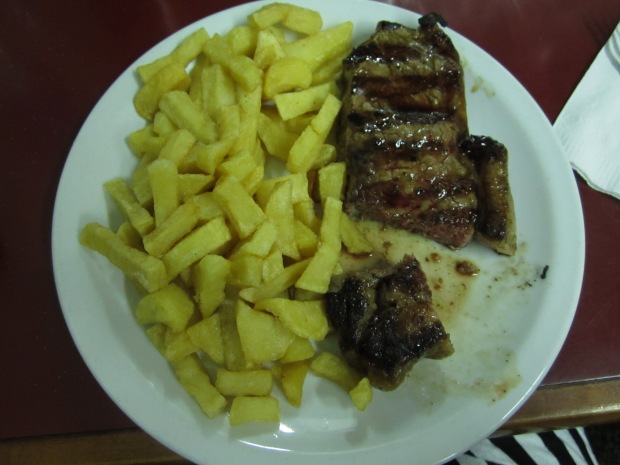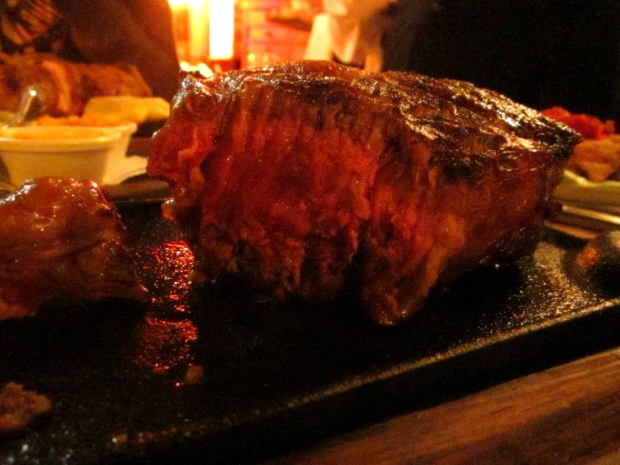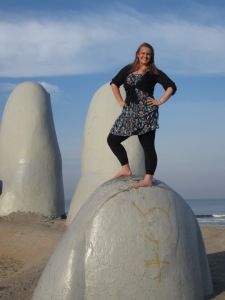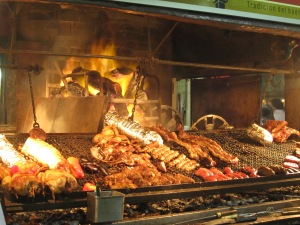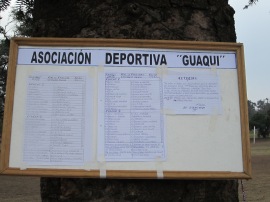Palermo Restaurants: Eating Like We’re Fancy on a Grad Student Budget
Posted by mandietuesday in South America on July 25, 2012
Even though we’re on a grad student budget (read: slightly broke), we both really wanted to experience the culinary amazingness that is Buenos Aires. Buenos Aires isn’t known for cheap food – in fact, eating out is relatively expensive here. In this post, I want to recount my three favorite restaurant experiences in Buenos Aires (Palermo specifically, as that’s where we lived) to prove that we really didn’t cook ourselves dinner every single night 🙂
CLUB EROS
This was the first restaurant we ate out at. A flight attendant friend, Mallory, was on a trip to Buenos Aires, so we decided to go out! We found this place based on reviews online, and everyone said it was good food, good prices, and in a strange location where it was right next to a gym. Literally, the restaurant was around the windows, there was a wall, and then a gym. And they were spot on! The atmosphere was basic, but the food was delicious and cheap. The waiters were really nice, too. Definitely recommend, if for nothing else, for the novelty aspect and solid food.
Address: Uriarte 1609 (on Honduras)
Phone number: 11 4832 1313
No website.
Price: About $13 USD for a steak, french fries, and a bottle of water.
LA CABRERA
There are not enough good things in the world for me to say about La Cabrera.
It’s sort of universally known as THE place to go get steak in Bueno Aires – no small feat for a city that’s known for its meat! However, it was a good bit out of our price range, which is why I have the greatest news in the world! HAPPY HOUR. That’s right, La Cabrera opens from 7-8:30 pm Monday-Thursday (and I would get there right at 7 or else it might be too full when you get there) where everything on the menu is half off. Steaks, appetizers, everything. I’ve read online that the wine is half off too, but w.hen we went there the first time, it wasn’t. The bottle was all of $15 so it’s fine, but just a heads up 🙂
Yes, the first time. This place was so good, we went there twice! The first was when I had another friend in town, Greg. He’d also heard of the place, so we headed over on a Monday night to experience the happy hour. And experience we did! They serve a plethora of small dishes with little “gustos” along with your meal, as well. The first time, I ordered the bife de chorizo (medium) and a side of french fries. The steak was the size of my head, I think, and perfectly cooked (jugoso)
The second time, Kristi and I went back two days before we left Buenos Aires as our farewell dinner. We specifically planned this in order to be able to spend the next day eating leftovers 🙂 This time, I decided to try their tortilla espanola made with artichokes and sundried tomatoes. The tortilla itself would have been enough for a meal, but luckily, I also ordered the ojo de bife (rib-eye steak, large). I have literally never had a steak this succulent before. It melted in my mouth, was gigantic (see the pictures!) and amazingly flavorful. I didn’t even need the chimichurri on it, but of course, I added some – also super delicious 🙂
Always amazing, tons of leftovers, quick service, and very friendly and attentive waiters. If I were going to take someone to any restaurant in Buenos Aires, this would definitely be the spot.
Address: José Antonio Cabrera 5099 (on Thames)
Phone number: 11 4831 7002
Website: http://www.parrillalacabrera.com.ar/
Price: I paid about $30-35 USD for each meal (appetizer/side, giant cut of beef, water/wine). Worth every single penny.
LA FABRICA DEL TACO
One of my favorite thins to do while abroad is eat at their Mexican restaurants. I just love to see what each culture reinterprets it as (or how well they keep it authentic), plus it’s very easy to get gluten-free food at a Mexican place! We had passed several Mexican places in our neighborhood, but this one was constantly coming up on review sites, so we decided to give it a try – and thank goodness we did!
The décor was incredibly funky, colorful, and bright. One wall was lined with luchador masks, with the others covered with posters, garden implements and paintings. We arrived right around 9 pm expecting them to have just opened, but there were already a few tables with people. We got a table right away and each ordered a jamaica margarita, which I hiiiiighly recommend. After glancing at other tables to guess at the size of the tacos, I ordered three – a Taco Pibe (carne asada and chimichurri), a Pastor (al pastor meat), and a Volcan (which was a crunchy flat taco shell covered in carne asada, guacamole, and cheese). Each taco had approximately half a pound of meat on them! There were three sauces available at the table – “for the Argentines,” “for those who dare,” and a medium sauce. I went for the Argentine salsa – I’m not much a spicy food person 🙂 Combined with the quick service, we were sold!
I actually happened (I wear, it wasn’t on purpose!) to pass by the restaurant on my way home from interviewing the next day, so I decided to surprise Kristi with some tacos para llevar. I went in and our waiter from the night before immediately recognized me – oops. I watched them make the tacos in front of me and could hardly keep myself from opening the bag up on the walk home to eat one! And now I just made myself want a taco by writing about them! I doubt the airport I’m sitting in [at the time of writing] has a taco stand, much less one this good 🙂
Address: Gorriti 5062 (on Thames)
Phone number: 11 4832 0815
Website: http://www.lafabricadeltaco.com/
Price: About $17 USD for three (large) tacos and a margarita.
The moral of the story is: even though eating out in Buenos Aires is definitely not the easiest budget-friendly option, there are some restaurants (and deals!) that don’t require taking a loan out, and are worth every single penny that you do spend 🙂
Uruguayan Adventures: A Whirlwind Trip Through Southern Uruguay
Posted by mandietuesday in South America on July 23, 2012
One of the main things I wanted to do/see while I was here was Iguazu Falls, closely followed by visiting Uruguay in general. When we looked into buying plane tickets from Buenos Aires to Iguazu (as opposed to an 18 hour bus ride that was very close in price anyway), we were surprised to see that buying a round-trip ticket from Montevideo to Puerto Iguazu was about $140 cheaper than a Buenos Aires – Puerto Iguazu ticket, even though our Montevideo – Puerto Iguazu flight includes a four hour stopover in Buenos Aires. Strange. Anyway, we decided to go to Uruguay first, fly out of Montevideo, arrive in Puerto Iguazu, and then on the way back, I’m going to just get off the plane in Buenos Aires so I can go pick up my luggage stored at Spencer’s host family’s house and then go to the other airport that night for my flight back home. Kristi’s going to fly out of Montevideo for a week in Brazil, so she’ll continue the flight the whole way. Easy, right?
We took the Seacat ferry service from Buenos Aires to Colonia. Note to those who are planning on the same: the Seacat service is a subsidiary/part of the Buquebus company, which is much more well-known. The only difference is that Seacat uses the smaller/less luxurious ferries, which obviously didn’t bother us one bit. It was something like less than half the price to take Seacat – about $37 USD each – and we were on a one-hour ferry instead of a three-hour one! You check in for the Seacat like it’s Buquebus – same terminal and everything. This had us a bit confused. The customs/immigration process was easy, and it seemed like we had just sat down on the ferry when we arrived in Colonia an hour later!
COLONIA
Colonia is one of the oldest European settlements in the region. It was the teeny-tiniest little town ever. We arrived at 10 am and left the next morning, which was plenty of time to see what we wanted to see. We climbed the lighthouse, wandered around, ate amazing grilled fish and pumpkin puree at an awesome funky restaurant called The Drugstore, watched the sunset from the beach, did some market shopping, and continuously overestimated the time/distance it would take to get somewhere. We walked past so many streets we meant to turn on because we were like “well, it’s eight blocks away, so let’s check in 10 minutes or so” and then it would be a four minute walk. Seriously adorable town.
PUNTA DEL ESTE
From Colonia, we took a bus to Montevideo, changed buses, and continued on to Punta del Este. Considered to be a hotspot of Argentine and Brazilian partying during the summer, we (in the middle of winter) found it to be a very quaint town that clearly would be awesome during the high season. It had a lot of high rise buildings, tourist shops, and beaches. Perhaps the most recognizable part of Punta del Este is the “Monument to the Drowned,” otherwise known as “The Giant Hand That’s Coming Out of the Sand.” I wish I were kidding when I said we spent over an hour playing on the hand and taking pictures of each other, but I’m not kidding. At all. We watched another sunset from the docks along the beach (we’re so romantic).
In both Colonia and Punta del Este, we stayed at branches of El Viajero Hostel, which I would definitely recommend. We paid something like $13 a night each at both of them, were in rooms of six beds (three bunk beds) that had the most ingenious system of putting the big storage lockers under the beds to save space, and the kitchen/living room areas were clean and easy to use. Plus, free breakfast in the mornings! Granted, being gluten-free means my breakfasts consisted of orange juice, coffee, and yogurt, since the rest of the offerings (bread/toast, cereal) weren’t things I can eat, but still! Three free cups of coffee a morning makes up for it 🙂
MONTEVIDEO
Finally, we took a bus back to Montevideo and found our final hostel (after a bit of random wandering). It’s often called a “sleepy capital city” and considered one of the smallest/slowest-paced capital cities of South America, so I wasn’t quite sure what to expect, but I loved it!
When we first arrived, I was staaaaarving, so we immediately hopped on a bus from our hostel to the Mercado del Puerto, located near the customs port. We’d read that it has a bunch of restaurants all squished inside with any type of grilled meat you can imagine – you can either sit at a regular table or pull up a seat at the counter. All the action is at the counter, so of course we went there! We split an asado tipico (a type of ribs) and a giant sausage, plus french fries for me! SO GOOD. I cannot get over how good this meat was. We paid something like $15 USD each and I was stuffed afterwards. It was ready super quick too! And the lovely ambiance doesn’t hurt at all! As it was already past 4pm after we ate, we leisurely strolled from the Mercado back to our apartment, which is about an hour’s walk. We stopped at all the main plazas and sights, got some gelato, took more dumb pictures – pretty much standard 🙂
Luckily, we were in Montevideo on Sunday morning, which is when the giant Feria de Tristan Narvaja happens! It was only about six blocks away from our hostel, too! It’s the kind of market that’s a mishmash of clothing, antiques, arts and crafts, paintings, hardware tools, toiletries, fruits and vegetables, cheeses and meats, and pretty much anything else you can imagine or want or need. I bought an old lady dress (that I’ll hem to knee-length which will slightly mitigate the old lady-ness, but let’s be honest, I like old lady dresses a lot of the time!) and some small paintings. Also, I found a copy of “La Gitanilla” by Cervantes!! I was talking with the vendor and telling him how it’s my favorite of all the Novelas Ejemplares, and gave him a 20 peso bill to pay for the 5 peso book (less than 25 cents USD). He didn’t have change and I didn’t have anything smaller so he just gave it to me for free! He said he was happy to see someone who really liked the book take it 😀
After heading back to the hostel to drop off my new purchases and make lunch, Kristi and I embarked on a wandering expedition that landed us in the Parque Rodo, where they just so happened to have paddleboats for rent on the lake! Considering it was less than a dollar each for a half hour, it was a no-brainer. There were ducks and bunnies and I was a happy camper! We walked along the Malecon at sunset, ending a lovely Sunday in the “sleepy capital” of Montevideo 🙂
This morning, we woke up early to catch a bus to the airport to head to Iguazu! It’ll be a day of lots of sitting (45 minute flight, four hour “productivity break,” 1.5 hour flight, bus to the city) but well worth it 🙂 When we arrived at the airport here we thought there would be an arrivals and departures section, which we clearly got wrong. We didn’t get off the bus when we were supposed to, and when the ticket checker came by as we were leaving the airport, he had the bus stop so we could get our bags and cross the parking lot to actually check in! Oops. Luckily, we’d taken a slightly earlier bus than necessary for situations just like that!
Hasta luego, Uruguay! Espero que nos vemos dentro de naaaaada 🙂
Hasta Ahora, Buenos Aires – TQM!
Posted by mandietuesday in Buenos Aires Fun on July 17, 2012
(TQM is a common abbreviation of “te quiero mucho” in Spanish – much like saying I ❤ U in English :))
I absolutely cannot believe I’m already leaving Buenos Aires tomorrow morning. I feel like I just got here a week ago – but when I think back on the things that I’ve accomplished here, I realize that I’ve been able to squeeze a lot in during this month!
On the touristy/cultural side, I’ve:
- Visited the Sunday San Telmo market.
- Toured the Casa Rosada.
- Ate lunch at the famed Cafe Tortoni.
- Toured the museum and stadium of River Plate.
- Wandered around La Boca and El Caminito.
- Daytripped to the Tigre/Delta.
- Had amazing asado at Spencer’s Argentine host family’s house! He came to Buenos Aires four years ago and lived with a host family, and we’ve kept in touch since then – so when Spencer told them I was coming to visit, we decided to have a delicious lunch! And delicious it was!!
- Checked out the Buenos Aires Cathedral, which is the least-cathedral-looking cathedral I have ever seen.
- Wandered down the Calle Florida, though after our shoe-shopping extravaganza in the leather district of Murillo, we didn’t have much shopping left to do!
- Toured the Congreso Nacional.
- Watched the Madres de Plaza de Mayo hold their 3:30 Thursday demonstration, which was amazing.
- Watched a tango singing show at the Botica del Angel.
Plus, I managed to somehow squeeze in plenty of academic/research-related events, I promise! I:
- Interviewed/spoke to professors, an NGO director and several employees/volunteers, a female soccer trainer, a Bolivian newspaper editor, and a Bolivian soccer league’s leadership and players.
- Helped set up and worked at an unrelated academic conference.
- Was on a radio show!
- Attended the Seminario de Migracion at the Universidad Nacional de San Martin.
- Was interviewed for a piece on efdeportes.com, a sports website.
- Went to the soccer fields twice in order to conduct interviews and better understand the mechanics of league formation and how that organization leads to migrant community cohesion.
I took the train, subte, taxi, and got over my irrational hatred of buses (at least in this city – thanks, the 34, 166, 55, 57, 39, 36, and 96).
Kristi and I jumped off of a moving bus so I could stop at my gluten-free bakery. I started saying some words with the “shhh” sound so people could understand me better (Cashhhe Honduras, por ashhha, la sishhha). The butcher at our neighborhood greeted me with a smile and a “good morning!” in English at 6pm. And then he handed me my change with the same uncovered hands that he used to cut up my chicken breasts.
Buenos Aires, congratulations. You’ve won my heart.
Hasta la vista, see you very soon, hasta pronto, nos vemos prontito, ate logo, hasta luego, catch you on the flip side, hasta ahora. ❤
“Me Siento Mas Boliviano Que Nunca”: Interviews and Observations on the Soccer Field
Posted by mandietuesday in Buenos Aires Research on July 17, 2012
For my final research post, I wanted to share a bit about one of the most important parts of my project: to conduct both interviews and participant observation with a Bolivian soccer league in Buenos Aires. As with much of my research, where exactly this would take place depended much on the contacts I made and where they led me. Dr. Manuel Cervantes at FUNCRUSUR connected me with Augustin Flores, who brought me to two different parks: Parque Avellaneda y Parque Roca. My first day there, I talked with several “mesas de directores,” where the league leaders keep the paperwork and such. The first day, I completed some general interviews about basic organizational structures and took a lot of pictures.
Two weeks later, I returned to the Parque Avellaneda to talk more formally with the president and committee leader of the Asociacion Deportiva Guaqui, Pedro and Rigoberto. The Asociacion Deportiva Guaqui (ADQ) includes mainly members from the town of Guaqui near Lake Titicaca, following the normal pattern of groups made up of individuals from the same region of Bolivia.
Pedro and Rigoberto were incredibly forthcoming with their information, providing a wealth of data relating to both organization and how the leagues create camaraderie within the colectividad. This information will support my final project by allowing me a closer understanding of the reasons for and consequences of the league: it provides a space for Bolivians to meet, escape discrimination (even “small” acts of discrimination, such as for their accent), and allows young people and adults alike a place to escape boredom that can lead to undesirable activities. Many of the people I spoke with mentioned this last aspect, stating that it provided an outlet for energy that could otherwise be spent drinking. As the title of this post indicates, Rigoberto stated that his involvement in the Bolivian league makes him “feel more Bolivian than ever.” This so clearly expresses the ways in which these leagues are working to maintain ethnic and national ties with the country of origin within the migrant community.
Perhaps most importantly, this research opens the way for numerous other, more sustained research opportunities. The ADG leaders estimated there are 50-100 other campeonatos bolivianos just within Bueos Aires. Considering this particular league has over 750 players in itself, there are a number of ways a broader project could be approached – surveys of all of the leaders of all of the campeonatos, surveys of all of the players of just one league, a more in-depth look at just one team. The opportunities are endless!
When I spoke with UBA professor Pablo Alabarces last week, we talked about the difference between a framework and a focus. The framework, in this project, is understanding how an immigrant group relates within its host society. But, by using the focus of soccer, I can see migration, societal relations, migrant groups, negotiation of identity, processes of inclusion and exclusion, and identification. If one important conclusion has come out of the research I just completed, before I even sit down to try to analyze the myriad implications it carries, it’s this: completing fieldwork absolutely reaffirmed my belief in soccer as a useful entrance point/focus of research, allowing a narrowed glimpse into the greater issues in life.
Posted by Amanda Tollefson – MA Candidate at CLACS
Understanding “la colectividad boliviana” in Buenos Aires Within a Greater/Global Context
Posted by mandietuesday in Buenos Aires Research on July 10, 2012
Benedict Anderson, best known as the author of Imagined Communities, asserts that newspapers can provide the “technical means for ‘re-presenting’ the kind of imagined community” that an immigrant community has created – in terms of my project, that the Bolivian community has created in Buenos Aires. Therefore, one of the facets of my research is to analyze the newspapers that are created for and by the Bolivian community to determine how they cover and describe sports. However, as most things tend to happen, this hasn’t gone exactly how I had planned. (Foreshadowing: it’s been better!)
First, I came to Buenos Aires with a list of about six Bolivian newspapers that I had found by scouring the web for mentions of them (as many don’t have an online presence). Upon arriving and speaking with Dr. Manuel Cervantes, he informed me that all but two of them were out of business. Luckily, he just so happened to be on the editorial board of one of those two (funny how these connections work!) so he set me up with a meeting with another editor. A few days before that interview, I googled Bolivia Unida and came up with not only their website, but their facebook page. The most recent post immediately caught my attention – there was going to be an academic conference at the Universidad Nacional de San Martin entitled “Seminar about Migrations, Cultural Identity, and Human Rights: The Actuality of Immigrants in Argentina.” Oh hey! That’s precisely what I’m looking at! I scrambled to fill out the registration form (this is around 11pm on Wednesday night, and the conference was on Friday) and prepared myself for my first international conference.

Ruben Giustinani, Argentina national senator, speaking at the Seminario sobre Migraciones, Identidad Cultural, y Derechos Humanos
I arrived at the conference unsure of what to expect. I found it was held in a small auditorium that seated maybe 80 – 100 people – and was surprised to see that at times, there was standing room only! The day was broken into four sections: “Migration and Cultural Identity,” “Migration Policy,” “Migrations and Human Rights,” and “The Voice of the Migrants.” Each section had a panel of speakers ranging from Alejandro Grimson, a professor of anthropology whose work I had read extensively before coming here; Ruben Giustiniani, an Argentine senator; and Martin Arias Duval, the Director Nacional de Migraciones.
As the question of migration in Argentina largely focuses on the Bolivian, Paraguayan, and Peruvian populations, this conference was a fantastic opportunity to listen to (and tape record!) some of the brightest minds from a variety of fields talking about the subject. Without going into detail about what each panel discussed, which would make this post the size of a short novel, I’ll just end this section with a quotation that Alejandro Grimson used to close the conference: “No habria migracion si no habria desigualdad.” There wouldn’t be migration if there weren’t inequality. Statistically speaking, those who choose to migrate for curiosity or love aren’t even a blip on the screen of those who migrate because their home country doesn’t offer enough economic opportunity. It brought home the concept that it is imperative that one understands migration within this greater context.
The week after the conference, I met with Ricardo Calderon of Bolivia Unida. Their website hasn’t been updated in over a year, but they have a current facebook account. I was curious about the ways in which they chose to report on sports to the Bolivian community (do they focus on Argentine teams? Bolivian teams? Professional level? Community level?).
I was surprised, then, when the conversation took a much different turn: Ricardo made it clear that he saw sport as an enjoyable past time for the Bolivian community, but that he believed there were much more important things to talk about in the paper than sports. The newspaper is seen as a vehicle for discussing and problematizing the issues within the community, and in his opinion, sport doesn’t play into that too much. He did give me nine back issues of the newspaper, however, and the penultimate page of each is all about sports. I’m bringing the papers back home to complete better and more detailed analysis upon arriving in New York.
The point of this seemingly jumbled together mix of activities? It’s been through one of my initial contacts, Dr. Manuel Cervantes at FUNCRUSUR, that I was able to meet with the editor of Bolivia Unida, and through my search for information about Bolivia Unida that I found out about the very pertinent conference I attended. Once again, the links in my chain-of-awesome-contacts are coming through for me!
Posted by Amanda Tollefson – MA Candidate at CLACS at NYU
Tigre and the Delta: “Pura Naturaleza” Just Outside of Buenos Aires
Posted by mandietuesday in Uncategorized on July 7, 2012
Kristi and I had read about (and heard from several locals) a day trip to a town called Tigre, which is on the Parana Delta about an hour and a half outside of Buenos Aires. As always, figuring out the transportation was a full 3/4 of the adventure, but we prevailed!

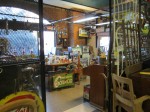 There are two trains that reach Tigre, the more scenic (and therefore more expensive) Tren de la Costa, and the much lower-cost but more boring TBA line. We chose to take the Tren de la Costa for the ride out there, which cost us .80 pesos to take the Mitre line from our stop until Mitre, walk through a small and very unexpected vintage fair to the Maipu station, and then 16 pesos for a tourist ticket (without an option for another type of ticket unless you’re an Argentine resident) which allowed us on/off privileges for the entirety of the ride there.
There are two trains that reach Tigre, the more scenic (and therefore more expensive) Tren de la Costa, and the much lower-cost but more boring TBA line. We chose to take the Tren de la Costa for the ride out there, which cost us .80 pesos to take the Mitre line from our stop until Mitre, walk through a small and very unexpected vintage fair to the Maipu station, and then 16 pesos for a tourist ticket (without an option for another type of ticket unless you’re an Argentine resident) which allowed us on/off privileges for the entirety of the ride there.
We chose to get off at the Barrancas stop first, because it had some cute little buildings as we pulled into the train station. We ate at a restaurant called El Molino, which had a kayak/windsurfing/scuba 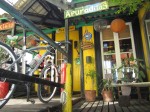 school and such attached. Adorable view, very relaxing, fun ambiance, very mediocre food. I mean, I love fake cheese more than most people, but a 24 peso plate of fake cheese and stale chips does not satisfy my nacho cravings.
school and such attached. Adorable view, very relaxing, fun ambiance, very mediocre food. I mean, I love fake cheese more than most people, but a 24 peso plate of fake cheese and stale chips does not satisfy my nacho cravings.
Boarding the train again, we got off at the next stop because everyone  said that San Isidro was THE stop to explore along the way. We enjoyed delicious iced coffee (and I made up for the lackluster nachos with a side of french fries, as usual) and wandered up to the cute little cathedral in town. Being winter, most things were closed (this is a repeating theme, by the way) and we hopped back on the train to take it all the way to Tigre soon after. Also, I may or may not get excited when I see bars/restaurants/any sort of establishment that have my name. That is all.
said that San Isidro was THE stop to explore along the way. We enjoyed delicious iced coffee (and I made up for the lackluster nachos with a side of french fries, as usual) and wandered up to the cute little cathedral in town. Being winter, most things were closed (this is a repeating theme, by the way) and we hopped back on the train to take it all the way to Tigre soon after. Also, I may or may not get excited when I see bars/restaurants/any sort of establishment that have my name. That is all.
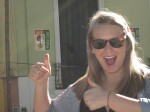 The town of Tigre itself? In a word, adorable, but I had the lingering feeling that it would be about a hundred times more awesome during the high season. Many shops were closed, particularly in the famed Puerto de Frutos, though this was probably for the best considering I had just enough pesos left to get me home after buying a surprisingly well-priced purse that was just the right size to fit my moleskine and a wallet. Excellent. We spent several hours just wandering around the city and river-gazing, however, and it was a fantastic little jornada outside of the bustle of the city for a day!
The town of Tigre itself? In a word, adorable, but I had the lingering feeling that it would be about a hundred times more awesome during the high season. Many shops were closed, particularly in the famed Puerto de Frutos, though this was probably for the best considering I had just enough pesos left to get me home after buying a surprisingly well-priced purse that was just the right size to fit my moleskine and a wallet. Excellent. We spent several hours just wandering around the city and river-gazing, however, and it was a fantastic little jornada outside of the bustle of the city for a day!
On the way back, we chose the boring TBA line, which cost a grand total of 2.15 pesos (1.35 for the 50 minute ride from Tigre to Retiro, and .80 from Retiro back up to our stop at Ministro Carranza). I quite like how we split the entertaining from the cheap, and would recommend doing it half and half if you’re interested. Granted, 16 pesos is just over $3.50 at the current exchange rate, so it’s not like it would have exactly broken the bank, BUT $.47 is obviously less and on a grad student budget, it’s the little things that count 🙂
Public Transportation in Buenos Aires: Or, Adventures in Lack of Integration
Posted by mandietuesday in Uncategorized on July 2, 2012
I love public transportation with all of my heart. I am all about subways and trains and buses (sometimes – I’ll get to that) and other forms of mass transit that get me from point A to point B cheaply and occasionally quickly. New York City has been fantastic in that regard, as you can imagine. However, while Buenos Aires boasts a variety of public transportation options, it’s been a bit of an ordeal figuring out where the subway stops are actually located, where the various independent train lines run and how they are(n’t) connected, and which bus will get me at least in the right direction. More on those in a moment.
Sidenote: it doesn’t help at all that a lot of maps are oriented with north to the top of the map, placing the water along the right hand/eastern side of the map, while others are oriented with the water to the bottom of the page.
As a general rule, though there are of course exceptions, my ranking of public transportation is thus:
- Subways. Metro, subte, the tube – no matter what you call it, I adore them. The best part is how every stop is always fixed. They’re not going to go off track (I mean, they can run on a different track in New York, but that’s a whole different story) or happen to stop on the next street over just because they feel like it. You can easily keep track of where you need to get off (either by reading the station names as you arrive and looking at the maps posted inside of the trains, or by counting ahead of time how many stops you have to go – this is particularly handy with non-Latin alphabets). They’re generally well-marked.
- Trains/trams. I’ve come across them less often than subways and buses, but they seem to do the trick. Sometimes don’t have as wide of a network within a city itself or tend to hit the tourist areas and that’s it, but they’re on my a-okay list.
- I rather dislike buses. They can go off “track,” they can skip a stop, maybe I don’t realize we’re on the street I want and by the time I hit the button to get off we missed it and I have to wait for the next one, maybe they just stop running but there’s nobody making an announcement at the bus stop to let you know that, etc.
Keeping that in mind, my opinions of the public transportation in Buenos Aires are on the slightly surprising side! Again, back to the major issues I’ve found (and how I’ve attempted to resolve them):
- Where the subway stops are actually located.
The map of the Subte here in Buenos Aires is fairly straightforward. This particular map even tells you what streets you’re going to be getting off on. Since I’ve been getting to know the city better, this has been mostly okay, but when I’m going to a new area of town, it takes me awhile to connect the stop on the map with the map of the area I’m going to. This is apparently harder than it looks or I’m doing something wrong. Googlemaps doesn’t show the stops, also.
As an aside, the subway is actually fairly limited in its scope here. It connects the city center well, but we’re living at the Ministro Carranza stop on the D/green train, so it’s the only train that’s accessible from our apartment but it’s a long ride to connect with anything else. Also, most of my interviews and research sites have been well outside of the reach of the subte in the afueras of the city.
The subway costs $2.50 ARS each ride, independent of distance, and there are no discounts for multiple rides purchased at once. I’ve been purchasing 10 ride tickets.
- Where the various independent train lines run and how they are(n’t) connected.
The train system within the city and its outskirts is quite extensive. However, as most of the tracks are run by different companies, it can be a hassle to figure out which of the trains connect, who’s running what, and which stops belong to which company. Lucky, I’ve figured out that the station that’s closest to my apartment (adjacent to the Ministro Carranza subte stop) is also called Ministro Carranza, and the Mitre and J. L. Suarez lines of TBA, which runs both the Mitre and Sarmiento lines, both run here. I’ve since used both of these lines, and once you get an idea of how it works, it’s handy. I did realize that when coming back when it was dark the other night, the stops are not at all lighted, so if I didn’t know what stop I wanted exactly and when to look out for it, I may have missed it.
The trains are $.80 ARS each way, which is the cheapest option that I’ve found.
- Which bus will get me at least in the right direction.
Oh, buses. I have been very surprised with the buses (usually called “colectivos”) here. Granted, I’ve only taken two separate lines, but buses are incredibly easy to use here. Used by something like 10 million people per average workday, they cover the vast majority of the capital and the outskirts. I’ve found a website called Omnilineas that is a godsend. You just click on the area you’re leaving from and where you want to go, and it gives you the various options that run by both of those! Considering that I often don’t have a direct address of my destination, just a park name or something, this has been much easier than using the address option. When I go from Palermo to Liniers, it’s a distance that Google Maps says would take 35 minutes to drive. I assumed it meant a bus would take at least an hour, but it turns out these are new “metrobus” lines that have a designated bus lane, bypassing traffic with ease! It was 35 minutes flat, including stopping at each of the 18 designated and well-marked bus stops. I pick it up on Honduras and take it to the end, to the Estacion Liniers.
The bus prices vary depending on the length of the ride, with a maximum price of $1.25 ARS.
One final note: as an attempt at some integration, the city introduced the SUBE card in 2009, which allows refills of up to 100 pesos at a time and can be used to pay for the subte or on buses. While I considered getting this card, it requires signing up with your passport at a center or post office and paying 10 pesos for the card itself. It would be a good idea for someone spending a significant amount of time here, but since I’m only in the city for a month and don’t use transportation every day (or use the train, which isn’t connected to the SUBE system), I’m just hoarding my coins to use on the bus.
“The Beautiful Game” in Buenos Aires: Transnationalism through Sport
Posted by mandietuesday in Uncategorized on June 26, 2012
One of the things that I love the most about my thesis topic is the reaction I get to the inevitable “so, what are you writing your thesis on?” question. When this question is asked by a professor or fellow grad student, I have a slightly longer response prepared, but when it’s asked by a casual acquaintance, my first answer is simply: “Soccer.”
I first started playing soccer when I was three years old; while I was never the fastest (by far) or the most skilled at footwork, I continued to play and love the sport through high school and onto college (and grad school!) intramural teams. I attended the 2010 World Cup in South Africa, obsessively follow Spain as a national team and Barcelona as a club, and yet had never really considered studying fútbol in a more academic way until I started at NYU. As it turns out, soccer is heavily studied by various academic fields – sociology, anthropology, history, ethnic studies, and even mathematics (statistical analysis), economics (the sport brings in billions of dollars worldwide), and science (does heading a soccer ball damage your brain? Are successful soccer players better thinkers than non-players?). For a sport that originated in mid 19th century Britain, it has spread across the world remarkably, and it would be hard to imagine modern-day Spain, Brazil, or Argentina without also picturing their fervent dedication to club teams, national teams, and the sport at large.
The research I’m doing while in Buenos Aires, then, somehow managed to work its way from “I want to go to South America and talk about soccer” to my current working research question: “With full awareness of the implications of the intersection of race, nationality, identity, and soccer within the Bolivian community in Buenos Aires, how and to what extent does this particular immigrant population use soccer to either negotiate integration into the local society or to sustain their distinct ethnic identity?” In brief, I hope to use soccer as a lens to understand the issues of transnationalism, migration, and discrimination that inevitably arise in this context.
I had been warned by many (professors, grad students who had completed their research already, and common sense) that the process of finding people who could help with my research and willingly be interviewed could be a difficult and tiring process. I’m not sure if I was just a researcher who spent her entire life helping burgeoning graduate students in a previous life and therefore karma is kicking in full speed, but I have been incredibly fortunate in this aspect. As this card I found in the San Telmo market proclaims, “lo importante no es saber, sino tener el telefono de quien sabe.” Truer words have never been spoken!
To begin with, there are two professors at the Universidad de Buenos Aires that are basically the academic experts of all things relating to fútbol and identity in Argentina. I met with Roberto Di Giano two days after arriving in Buenos Aires, and spoke with him at length about the fundamentals of soccer in this country, the history behind it, and the issues of discrimination and racism that are quite prevalent today. I will be meeting with the other professor, Pablo Alabarces, this coming week. I feel so fortunate to be able to meet with them.
Secondly, one of the NGOs that works with the Bolivian community in Buenos Aires has been helpful beyond what I could have hoped for. Called FUNCRUSUR (Fundacion Comunitaria Cruz del Sur), they are headquartered in the “microcentro boliviano” neighborhood of Liniers and work in various areas including health care, community involvement, legal issues, education, and diversion. I met with the NGO’s director, Dr. Manuel Cervantes, and he has connected me with a variety of individuals that will be able to help in the specific aspects of my research. (As a side note, I’ll be speaking about my project on the NGO’s community radio station tomorrow in the 1pm – 2pm slot [one hour ahead of EST] – it streams live online, so listen if you get the chance!)
To sum it up, I have been ridiculously lucky in so many ways already – and I haven’t even been in Buenos Aires for a full week yet! Not only have my contacts been helpful and forthcoming, but they continuously connect me with others that they think will be able to help as well. Perhaps most importantly, however, is the fact that I’m realizing more and more that while my project can perhaps seem silly on the surface, there is a mountain of incredibly important issues underneath just waiting to be discussed. Dr. Cervantes stated that one of the main reasons his NGO reaches out to adolescents through activities such as art and sports is: “Para que no tengan verguenza de su identidad, no tengan miedo de su cultura, y entiendan otras culturas.” [“So that they’re not ashamed of their identity, they’re not afraid of their culture, and they understand other cultures.”]
Yes, I’m talking about soccer, but it’s so much more than just a sport.
Just a little touch of star quality – Hello, Buenos Aires!
Posted by mandietuesday in Uncategorized on June 23, 2012
Buen dia! I’ve only been in Buenos Aires for five days now, but we’ve done so many things in that time that it feels like much longer!
Highlights of travel:
- Kristi’s connecting flight was canceled, so she had to arrive a day late. I hastily made a reservation at a hostel about 20 minutes away from my apartment, since I couldn’t check in without the money that we had decided Kristi would hold since we KNEW she would get here (and we all know that flying standby can be an adventure!) – thanks, irony.
- I actually slept for a few hours on the plane, which is a small miracle in itself.
- For future reference for everyone else: when you leave the airport, take the Manuel Tienda Leon bus to the centro. There, you get off the bus and they’ll transfer you to a car (along with a few other people in the same area) and take you to your hotel within a 5km radius. It’s only 75 ARS (about $17 USD), so a quarter of the price of a taxi, but fairly quick and very painless.
I found out while looking at the hostel page later that they explicitly said THIS IS A PARTY HOSTEL,  which is not exactly what my old body wanted after two days of travel, but it is what it is. I did make friends with one of the workers there, if by “make friends” you mean “he held the door open for me when I came back from the grocery store and told me he recognized me and I realized it was because I walked in on him in the bathroom earlier that day,” but hey, I’ll take what I can get!
which is not exactly what my old body wanted after two days of travel, but it is what it is. I did make friends with one of the workers there, if by “make friends” you mean “he held the door open for me when I came back from the grocery store and told me he recognized me and I realized it was because I walked in on him in the bathroom earlier that day,” but hey, I’ll take what I can get!
The hostel was a very cool, funky space, however.
Kristi arrived the next morning and we checked into our piso!
Why yes, we are swanky (and didn’t even really know it…).
And on the inside:
(Kristi, modeling her… guide book? I think?)
Clearly there isn’t an overabundance of space, but it’s perfectly functional for what we’re using it for. Plus, our building has a washer AND dryer, which is insane, so that’s fantastic. And our comforter is comfy! And we have a little balcony with a table and chairs!
The first day we were here was a Wednesday, which also happened to be National Flag Day (which commemorates the birthday of Manuel Belgrano, the creator of the Argentine flag). This means that everything was closed, which meant that when we were surprised by the fact that our apartment uses Australian/Chinese outlets instead of Argentine ones, there was nowhere to buy adapters. We’ve since done some research and realized that it appears the country is in the process of switching to these types of outlets, but apparently neither Kristi nor I came across this in our preparations, as we both only brought converters for the old style. We found a hardware store that sold them on Thursday, though, so all is well!
I’ll be updating soon with an actual research post (and be excited – I’ve been having amazing luck and we’re incredibly fortunate to have some awesome contacts here, so it’s getting good!), but for now, off to explore the city some more 🙂

